Abstract
BACKGROUND--Beta 2 adrenergic dysfunction may be one of the underlying mechanisms responsible for atopy and bronchial asthma. The gene encoding the human beta 2 adrenergic receptor (beta 2ADR) has recently been isolated and sequenced. In addition, a two allele polymorphism of this receptor gene has been identified in white people. A study was carried out to determine whether this polymorphism is functionally important and has any relation to airways responsiveness, atopy, or asthma. METHODS--The subjects studied were 58 family members of four patients with atopic asthma. Restriction fragment length polymorphism (RFLP) with Ban-I digestion of the beta 2ADR gene was detected by a specific DNA probe with Southern blot analysis. Airways responses to inhaled methacholine and the beta 2 agonist salbutamol, the skin prick test, and serum IgE levels were also examined and correlated to the beta 2ADR gene RFLP. In addition, measurements of cAMP responses to isoproterenol in peripheral mononuclear cells were performed in 22 healthy subjects whose genotype for beta 2ADR was known. RESULTS--A two allele polymorphism (2.3 kb and 2.1 kb) of the beta 2ADR gene was detected in the Japanese population. Family members without allele 2.3 kb (homozygote of allele 2.1 kb) had lower airways responses to inhaled salbutamol than those with allele 2.3 kb. The incidence of asthma was higher in those without allele 2.3 kb than in those with allele 2.3 kb. The beta 2ADR gene RFLP had no relation to airways responses to methacholine and atopic status. cAMP responses in peripheral mononuclear cells of the subjects without allele 2.3 kb tended to be lower than those of the subjects with allele 2.3 kb. CONCLUSIONS--These results suggest that Ban-I RFLP of the beta 2ADR gene may have some association with the airways responses to beta 2 agonists and the incidence of bronchial asthma.
Full text
PDF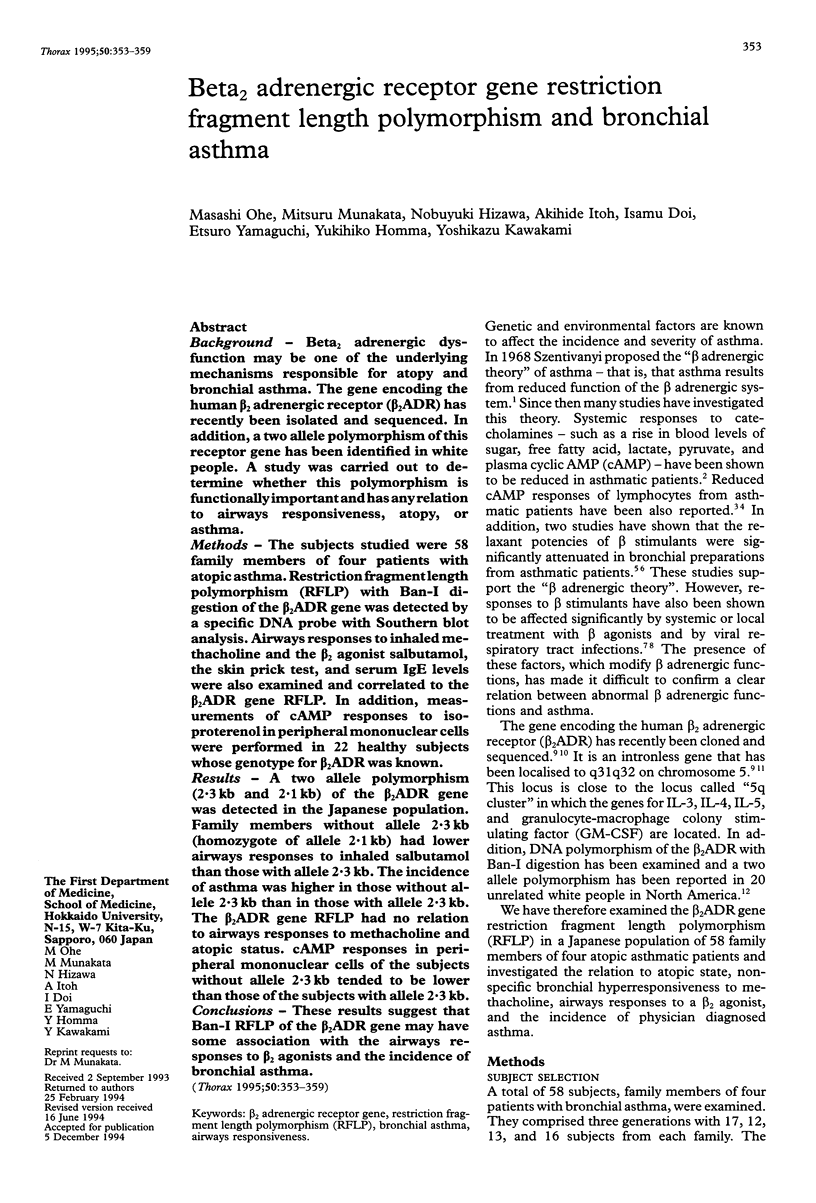
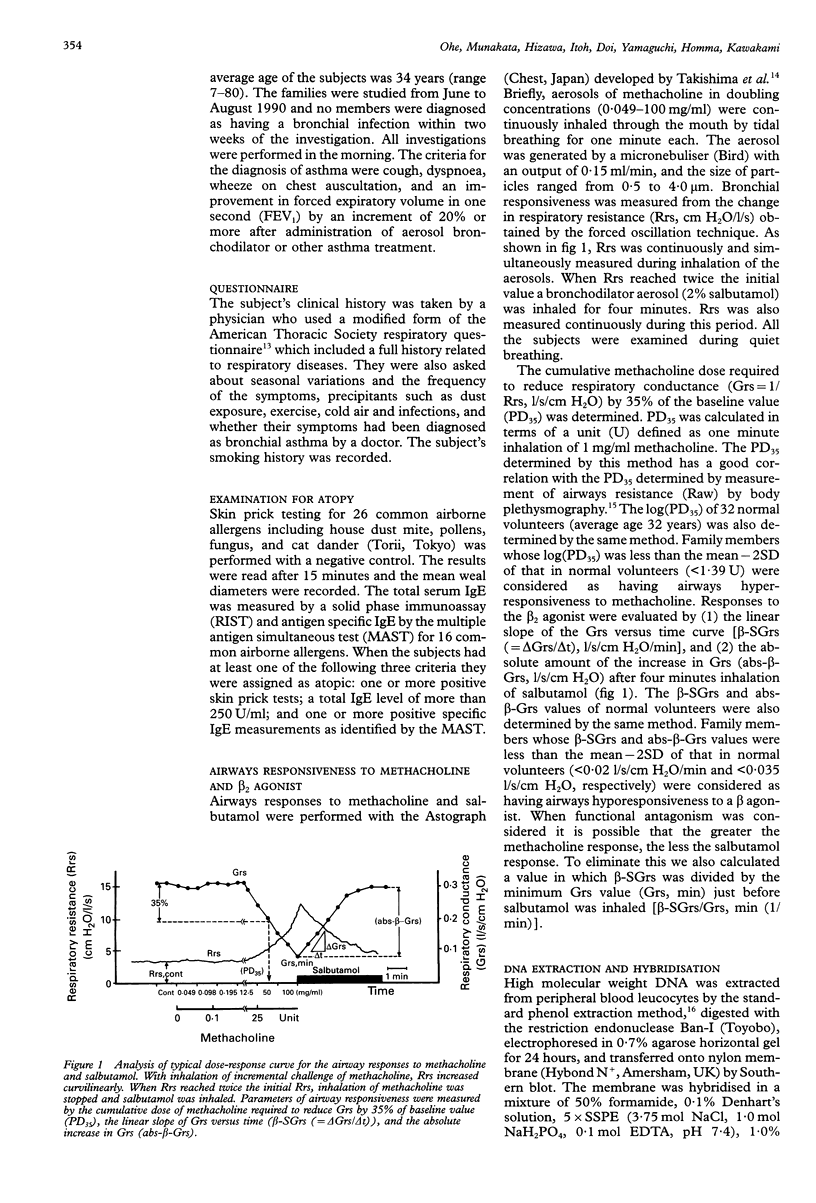
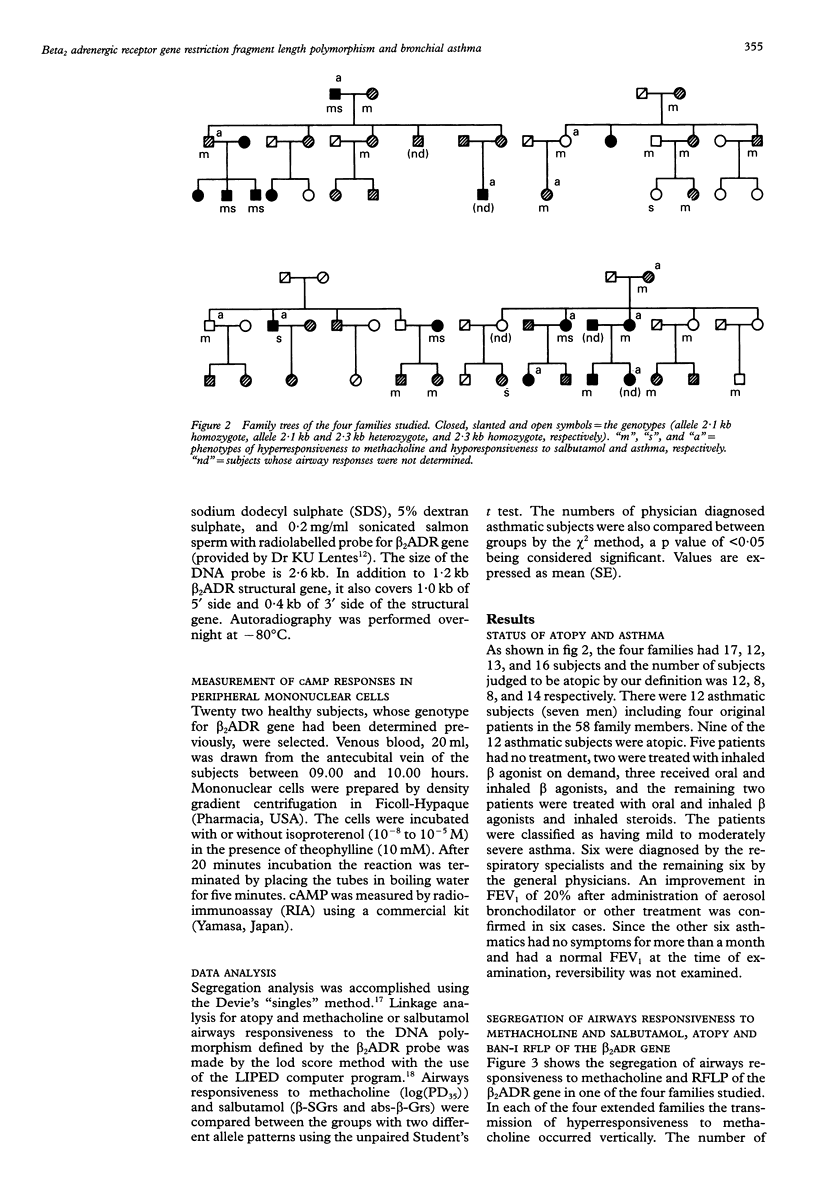
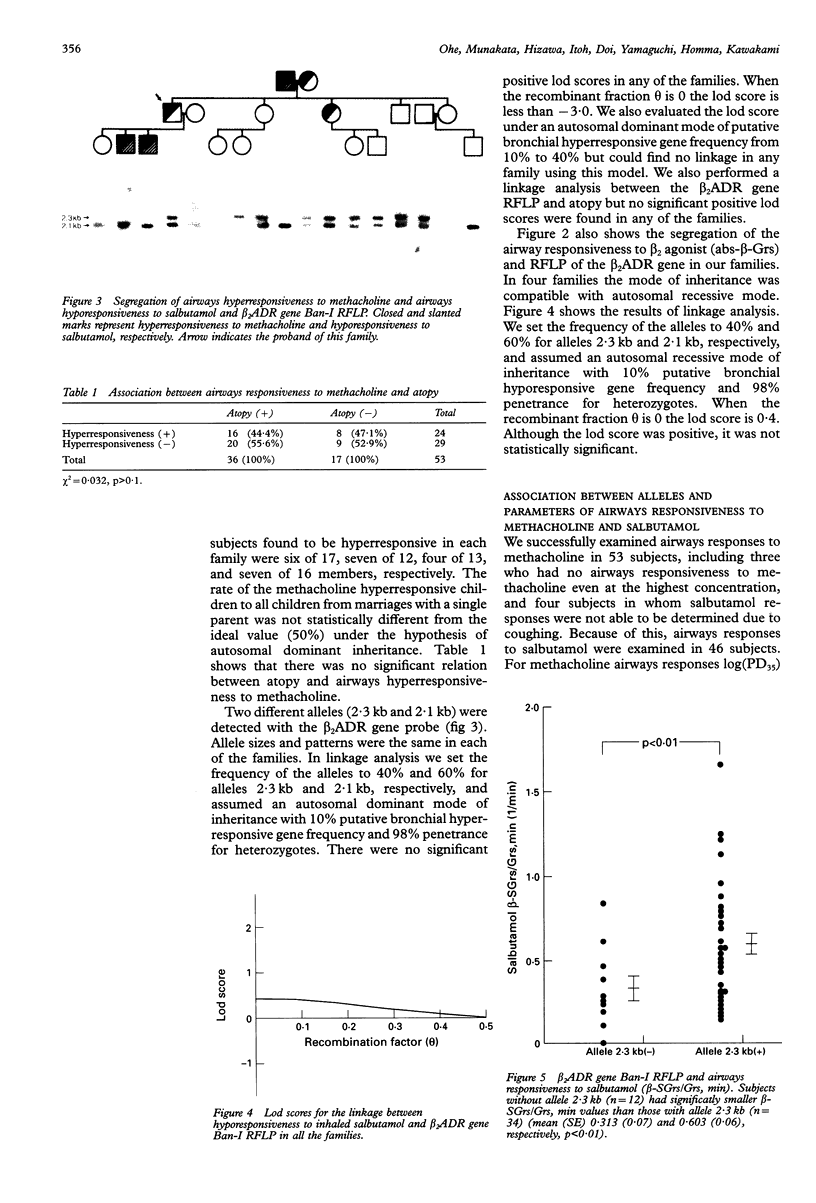
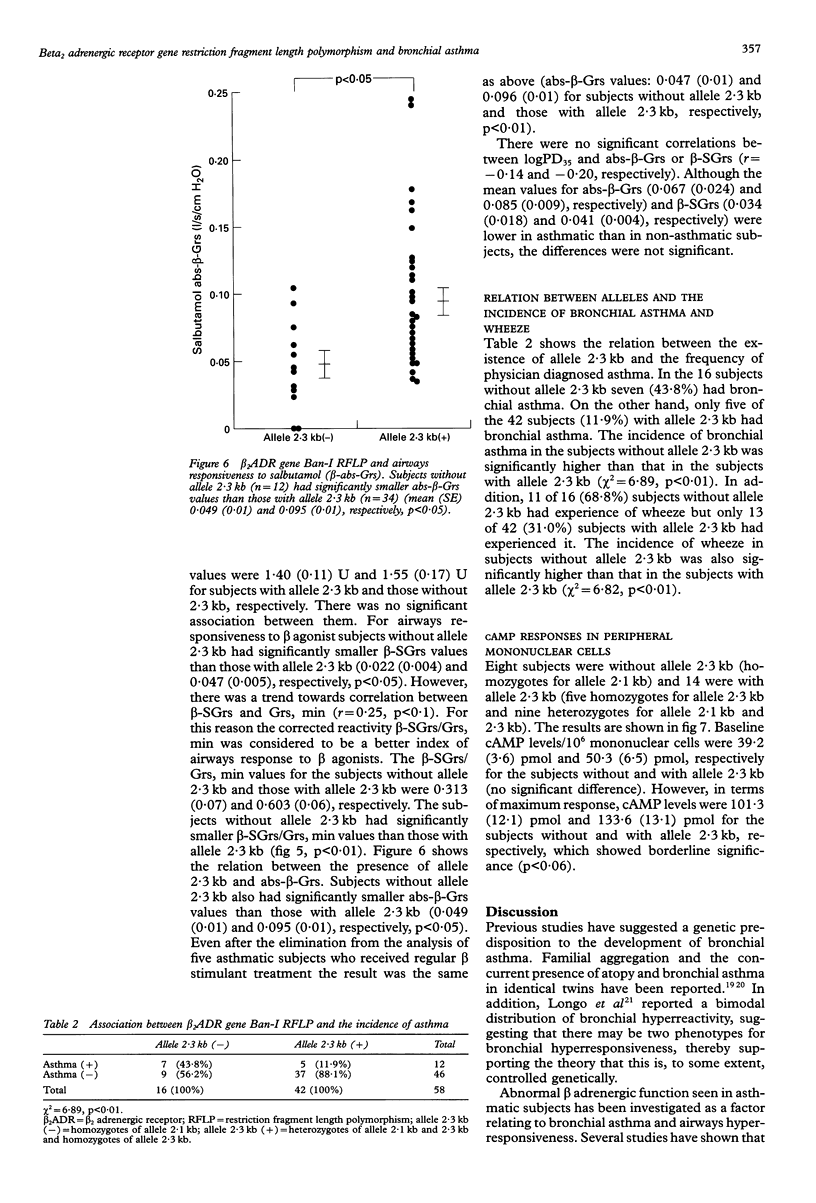
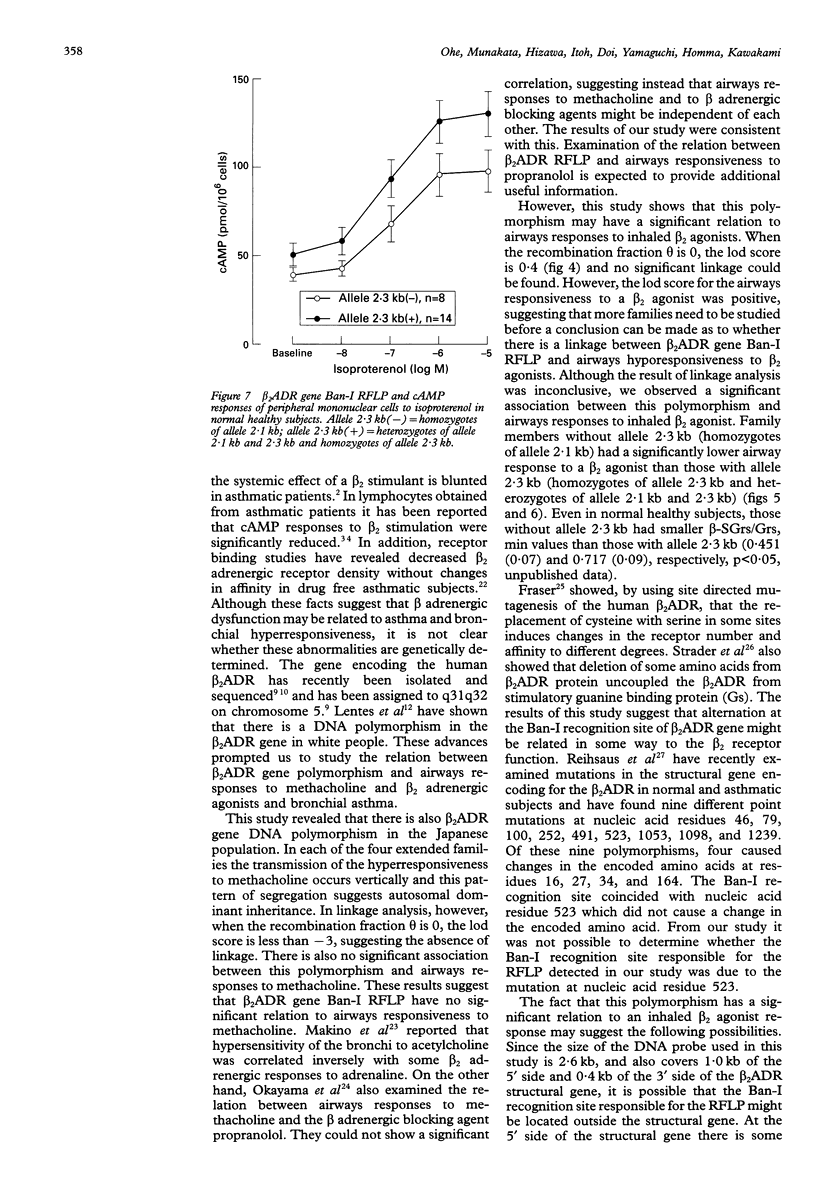
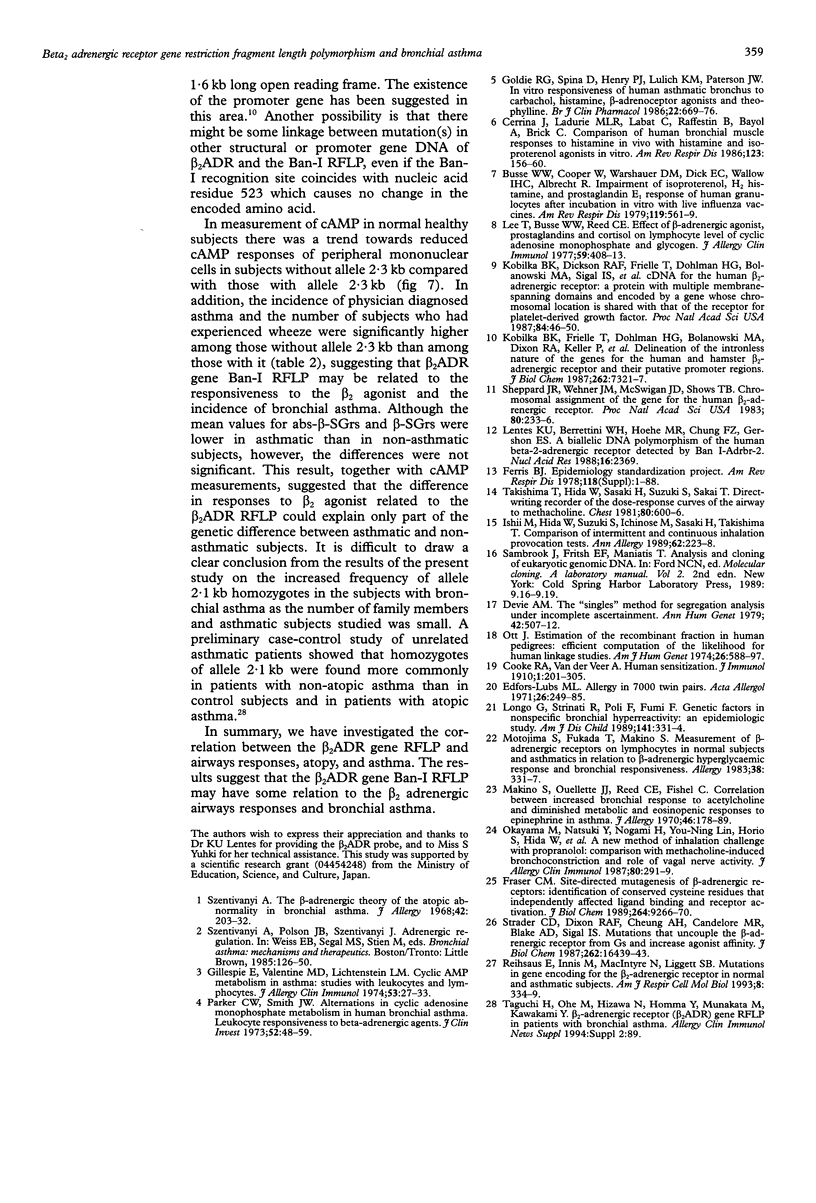
Images in this article
Selected References
These references are in PubMed. This may not be the complete list of references from this article.
- Busse W. W., Cooper W., Warshauer D. M., Dick E. C., Wallow I. H., Albrecht R. Impairment of isoproterenol, H2 histamine, and prostaglandin E1 response of human granulocytes after incubation in vitro with live influenza vaccines. Am Rev Respir Dis. 1979 Apr;119(4):561–569. doi: 10.1164/arrd.1979.119.4.561. [DOI] [PubMed] [Google Scholar]
- Cerrina J., Denjean A., Alexandre G., Lockhart A., Duroux P. Inhibition of exercise-induced asthma by a calcium antagonist, nifedipine. Am Rev Respir Dis. 1981 Feb;123(2):156–160. doi: 10.1164/arrd.1981.123.2.156. [DOI] [PubMed] [Google Scholar]
- Davie A. M. The 'singles' method for segregation analysis under incomplete ascertainment. Ann Hum Genet. 1979 May;42(4):507–512. doi: 10.1111/j.1469-1809.1979.tb00683.x. [DOI] [PubMed] [Google Scholar]
- Edfors-Lubs M. L. Allergy in 7000 twin pairs. Acta Allergol. 1971 Aug;26(4):249–285. doi: 10.1111/j.1398-9995.1971.tb01300.x. [DOI] [PubMed] [Google Scholar]
- Ferris B. G. Epidemiology Standardization Project (American Thoracic Society). Am Rev Respir Dis. 1978 Dec;118(6 Pt 2):1–120. [PubMed] [Google Scholar]
- Fraser C. M. Site-directed mutagenesis of beta-adrenergic receptors. Identification of conserved cysteine residues that independently affect ligand binding and receptor activation. J Biol Chem. 1989 Jun 5;264(16):9266–9270. [PubMed] [Google Scholar]
- Gillespie E., Valentine M. D., Lichtenstein L. M. Cyclic AMP metabolism in asthma: studies with leukocytes and lymphocytes. J Allergy Clin Immunol. 1974 Jan;53(1):27–33. doi: 10.1016/0091-6749(74)90096-7. [DOI] [PubMed] [Google Scholar]
- Goldie R. G., Spina D., Henry P. J., Lulich K. M., Paterson J. W. In vitro responsiveness of human asthmatic bronchus to carbachol, histamine, beta-adrenoceptor agonists and theophylline. Br J Clin Pharmacol. 1986 Dec;22(6):669–676. doi: 10.1111/j.1365-2125.1986.tb02956.x. [DOI] [PMC free article] [PubMed] [Google Scholar]
- Ishii M., Hida W., Suzuki S., Ichinose M., Sasaki H., Takishima T. Comparison of intermittent and continuous inhalation provocation tests. Ann Allergy. 1989 Mar;62(3):223–228. [PubMed] [Google Scholar]
- Kobilka B. K., Dixon R. A., Frielle T., Dohlman H. G., Bolanowski M. A., Sigal I. S., Yang-Feng T. L., Francke U., Caron M. G., Lefkowitz R. J. cDNA for the human beta 2-adrenergic receptor: a protein with multiple membrane-spanning domains and encoded by a gene whose chromosomal location is shared with that of the receptor for platelet-derived growth factor. Proc Natl Acad Sci U S A. 1987 Jan;84(1):46–50. doi: 10.1073/pnas.84.1.46. [DOI] [PMC free article] [PubMed] [Google Scholar]
- Kobilka B. K., Frielle T., Dohlman H. G., Bolanowski M. A., Dixon R. A., Keller P., Caron M. G., Lefkowitz R. J. Delineation of the intronless nature of the genes for the human and hamster beta 2-adrenergic receptor and their putative promoter regions. J Biol Chem. 1987 May 25;262(15):7321–7327. [PubMed] [Google Scholar]
- Lee T. P., Busse W. W., Reed C. E. Effect of beta adrenergic agonist, prostaglandins, and cortisol on lymphocyte levels of cyclic adenosine monophosphate and glycogen: abnormal lymphocytic metabolism in asthma. J Allergy Clin Immunol. 1977 Jun;59(6):408–413. doi: 10.1016/0091-6749(77)90002-1. [DOI] [PubMed] [Google Scholar]
- Longo G., Strinati R., Poli F., Fumi F. Genetic factors in nonspecific bronchial hyperreactivity. An epidemiologic study. Am J Dis Child. 1987 Mar;141(3):331–334. doi: 10.1001/archpedi.1987.04460030109037. [DOI] [PubMed] [Google Scholar]
- Makino S., Ouellette J. J., Reed C. E., Fishel C. Correlation between increased bronchial response to acetylcholine and diminished metabolic and eosinopenic responses to epinephrine in asthma. J Allergy. 1970 Sep;46(3):178–189. doi: 10.1016/0021-8707(70)90096-1. [DOI] [PubMed] [Google Scholar]
- Motojima S., Fukuda T., Makino S. Measurement of beta-adrenergic receptors on lymphocytes in normal subjects and asthmatics in relation to beta-adrenergic hyperglycaemic response and bronchial responsiveness. Allergy. 1983 Jul;38(5):331–337. doi: 10.1111/j.1398-9995.1983.tb04127.x. [DOI] [PubMed] [Google Scholar]
- Okayama M., Yafuso N., Nogami H., Lin Y. N., Horio S., Hida W., Inoue H., Takishima T. A new method of inhalation challenge with propranolol: comparison with methacholine-induced bronchoconstriction and role of vagal nerve activity. J Allergy Clin Immunol. 1987 Sep;80(3 Pt 1):291–299. doi: 10.1016/0091-6749(87)90034-0. [DOI] [PubMed] [Google Scholar]
- Ott J. Estimation of the recombination fraction in human pedigrees: efficient computation of the likelihood for human linkage studies. Am J Hum Genet. 1974 Sep;26(5):588–597. [PMC free article] [PubMed] [Google Scholar]
- Parker C. W., Smith J. W. Alterations in cyclic adenosine monophosphate metabolism in human bronchial asthma. I. Leukocyte responsiveness to -adrenergic agents. J Clin Invest. 1973 Jan;52(1):48–59. doi: 10.1172/JCI107173. [DOI] [PMC free article] [PubMed] [Google Scholar]
- Reihsaus E., Innis M., MacIntyre N., Liggett S. B. Mutations in the gene encoding for the beta 2-adrenergic receptor in normal and asthmatic subjects. Am J Respir Cell Mol Biol. 1993 Mar;8(3):334–339. doi: 10.1165/ajrcmb/8.3.334. [DOI] [PubMed] [Google Scholar]
- Sheppard J. R., Wehner J. M., McSwigan J. D., Shows T. B. Chromosomal assignment of the gene for the human beta 2-adrenergic receptor. Proc Natl Acad Sci U S A. 1983 Jan;80(1):233–236. doi: 10.1073/pnas.80.1.233. [DOI] [PMC free article] [PubMed] [Google Scholar]
- Stiege W., Stade K., Schüler D., Brimacombe R. Covalent cross-linking of poly(A) to Escherichia coli ribosomes, and localization of the cross-link site within the 16S RNA. Nucleic Acids Res. 1988 Mar 25;16(6):2369–2388. doi: 10.1093/nar/16.6.2369. [DOI] [PMC free article] [PubMed] [Google Scholar]
- Strader C. D., Dixon R. A., Cheung A. H., Candelore M. R., Blake A. D., Sigal I. S. Mutations that uncouple the beta-adrenergic receptor from Gs and increase agonist affinity. J Biol Chem. 1987 Dec 5;262(34):16439–16443. [PubMed] [Google Scholar]
- Takishima T., Hida W., Sasaki H., Suzuki S., Sasaki T. Direct-writing recorder of the dose-response curves of the airway to methacholine. Clinical application. Chest. 1981 Nov;80(5):600–606. doi: 10.1378/chest.80.5.600. [DOI] [PubMed] [Google Scholar]



